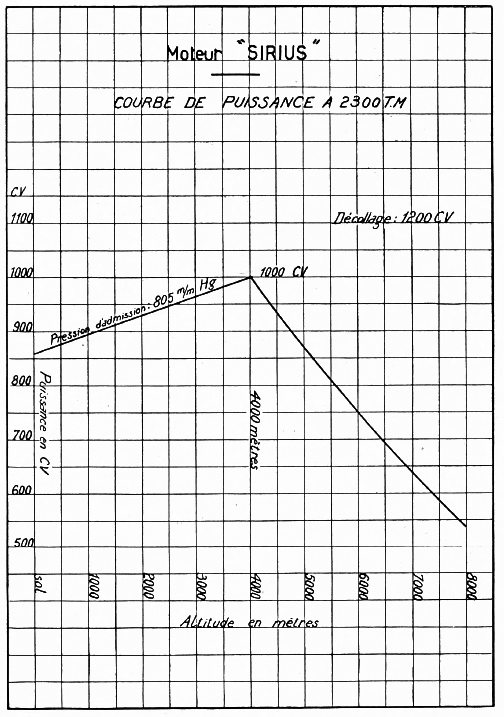
|
18 cylinder engine arranged in 2 rows of radial patterns around the crankcase. Bore: 140. Course: 166. Total cylinder capacity: 45 1,900. Rated power: 1,000 HP at 4,000 meters. Rated speed: 2,300 RPM. Takeoff power: 1,300 HP. Compression ratio: 6. Reduction of the helical gearbox: 11/17. Multiplication of the supercharger: 9,1/1. Fuel consumption: 265 grs at HP/H. Oil consumption: 15 grs at HP/H. Engine weight (according to standard 7021): 675 kgs. Size (see plate). |
The Lorraine <<Sirius>> 18-cylinder, air-cooled, type 112 air-cooled aviation engine is currently in the early stages of development. Indeed, this engine of nearly 46 liters of displacement is likely to have a greatly increased power.
The S.N.C.M. has indeed assigned for this engine a first power limit: 1,000 HP, to allow the systematic study of the various parts for their possible modification or confirmation for the evolution of the engine to a much higher power. As it currently stands, its construction features are as follows:
Oilpan. - In three pieces forged alugir. The forged metal, in addition to its higher strength, gives a greater safety coefficient than the cast metal, as a result of better homogeneity.
The bearing support webs are an integral part of the housing, which gives a perfect rigidity of the shaft line.
The AV bearing is a double roller, forming a stop for the crankshaft.
The middle bearing is a roller, as well as the AR bearing.
Cylinders. - The cylinders are composed of two assembled parts: the barrel and the cylinder head.
The barrel is made of high strength treated steel, with large cooling fins.
The cylinder head is cast aluminum, to which are attached, hot-screwed, the steel intake valve seat, the exhaust valve seat and the bronze spark plug and starter seats. The breech is likewise screwed hot and fretted on the barrel; very wide fins ensure cooling, even in the worst conditions.
Crankshaft. - The crankshaft is in 4 parts, with assembly by cone and key ensuring an absolute rigidity.
The 2-pin crankshaft at 180° is supported by three bearings. It drives to the AV the gear reducer plate and to the AR the compressor control and accessory controls.
It is equipped with a central bearing, which has the advantage of increasing the stiffness of the shaft line and eliminating any vibration, whatever the speed.
Engine coupling. - The two rows are each constituted by a master rod, with 8 links and their pistons.
The main rod is in one piece, double-T section, and journalled on the crankshaft by means of a bronze floating pad, internally and externally regulated.
The rod has a fork-shaped head, the axis being supported on the main rod by 3 eyes.
The piston is forged alugir and carries 3 pressure segments and 2 double scraper segments.
Distribution. - Each cylinder includes:
Lubrication. - The oil is circulated by 2 gear pumps.
1 high-volume pump sends the oil under pressure into the crankshaft and ensures the lubrication of the various components.
1 drain pump returns to the tank the oil recovered in the sump, through the carburetor to heat it.
Supercharger. - It is of the centrifugal type with only one speed, assuring to its turbine a multiplication of speed of 9.1, and restoring the pressure to 4.000 m. altitude.
The turbine is in electron and is supported by 2 bearings: one with rollers, the other with smooth ring.
The compressor control is of Lorraine type with epicyclic train with torsion shaft and oil control clutch by inertia valve.
Carburetor. - To facilitate resumption and starts, the carburetor is in charge on the supercharger, it is equipped with an intake limiter and an automatic gasoline corrector.
Ignition. - The ignition is of the shielded type.
Gearbox. - Lorraine type with epicyclic gear train.
Reduction ratio: 11/17.
Accessory controls. - These controls are operated via torsion shafts.
They are divided into:
 |
| [ | Previous | | | France | | | Index | | | Next | ] |
| [ | Home | | | About | | | Contact | | | Top | ] |
Translated with Google Translate